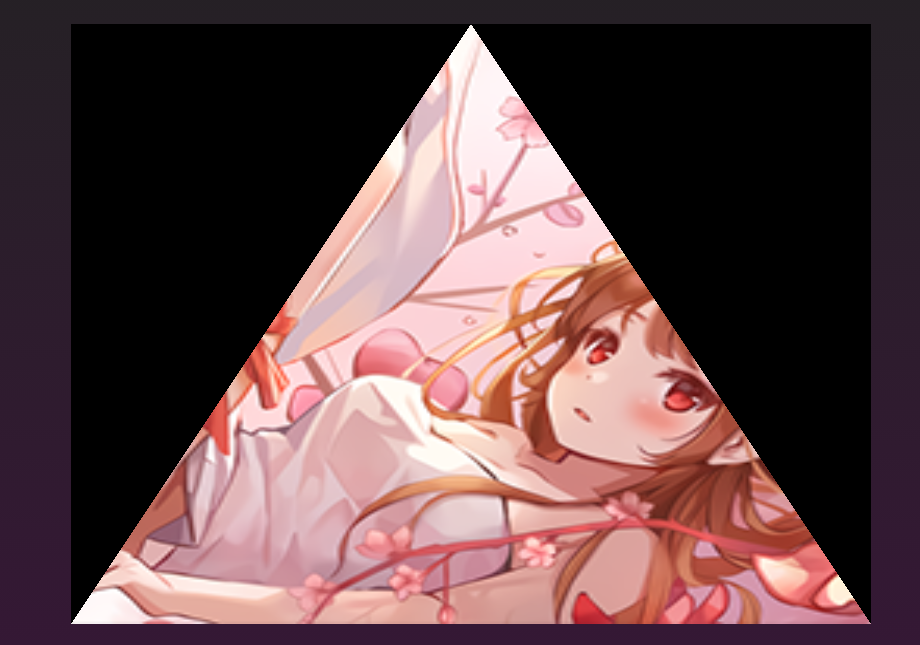WebGPU[4] 纹理三角形
代码见:https://github.com/onsummer/my-dev-notes/tree/master/webgpu-Notes/04-texture-triangle
原创,发布日 2021年4月5日,更新日 2021年5月6日,@秋意正寒。若代码失效请留言,或自行到官网根据最新 API 修改。

数据预览
NDC 坐标和 纹理坐标(原点、朝向、值域)基础不再补充。
0.1 VBO
// 注意,VBO中的三角形顶点坐标 ((-1.0, -1.0), (0.0, 1.0), (1.0, -1.0)) 是顺时针顺序
const vbodata = new Float32Array([
-1.0, -1.0, 0.0, 1.0,
0.0, 1.0, 0.5, 0.0,
1.0, -1.0, 1.0, 1.0
])
0.2 贴图
一张 256 x 256 的 png 贴图,jpg 和 webp 没测试。

1 纹理与采样器
使用采样器在纹理贴图上,通过纹理坐标取顶点的颜色值,这是一个很常规的操作。
1.1 创建采样器、纹理
/* create sampler */
const sampler = device.createSampler({
minFilter: "linear",
magFilter: "linear"
})
/* --- create img source --- */
const img = document.createElement('img')
img.src = 'texture.png'
// 用 await 代表这个操作必须在 async 函数中,或者在 html 中提前做好 img 标签并加载纹理贴图
await img.decode()
const imageBitmap = await createImageBitmap(img)
/* create texture */
const texture = device.createTexture({
size: [img.width, img.height], // 256, 256 -> 2d的纹理
format: "rgba8unorm",
usage: GPUTextureUsage.SAMPLED | GPUTextureUsage.COPY_DST
})
1.2 将纹理贴图数据 填入 纹理对象
我在文档中看到有两个方法,一个是 GPUQueue.prototype.writeToTexture(),另一个是下面这个 GPUQueue.prototype.copyImageBitmapToTexture():
device.queue.copyImageBitmapToTexture(
{ imageBitmap: imageBitmap },
{ texture: texture },
[img.width, img.height, 1]
)
至此,采样器、纹理对象都准备好了,纹理数据也写入纹理对象中了。
2 将纹理对象、采样器对象传进流水线(Pipeline)
要向渲染通道传递纹理和采样器,必须创建一个 “Pipeline布局” 对象。
这个布局对象要对纹理对象、采样器对象进行绑定。在 WebGPU 中,将诸如 uniform变量、采样器、纹理对象 等资源统一打组,这个组叫 GPUBindGroup。
它们的关系图大概是这样的:

上代码:
/* 创建绑定组的布局对象 */
const bindGroupLayout = device.createBindGroupLayout({
entries: [
{
/* use for sampler */
binding: 0,
visibility: GPUShaderStage.FRAGMENT,
sampler: {
type: 'filtering',
},
},
{
/* use for texture view */
binding: 1,
visibility: GPUShaderStage.FRAGMENT,
texture: {
sampleType: 'float'
}
}
]
})
/* 创建 Pipeline 的布局对象 */
const pipelineLayout = device.createPipelineLayout({
bindGroupLayouts: [bindGroupLayout],
})
/* 创建 pipeline 时,传递 Pipeline 的布局对象 */
const pipeline = device.createRenderPipeline({
layout: pipelineLayout, // <- 传递布局对象
// ... 其他
})
/* 创建绑定组:GPUBindGroup,一组资源 */
const uniformBindGroup = device.createBindGroup({
layout: pipeline.getBindGroupLayout(0), // <- 指定绑定组的布局对象
entries: [
{
binding: 0,
resource: sampler, // <- 传入采样器对象
},
{
binding: 1,
resource: texture.createView() // <- 传入纹理对象的视图
}
]
})
3 修改着色器
光将采样器、纹理对象传入流水线还是不够的,在顶点着色器阶段、片元着色器阶段,仍需要把颜色给弄到。
3.1 顶点着色器
[[builtin(position)]] var<out> out_position: vec4<f32>;
[[location(0)]] var<out> out_st: vec2<f32>; // <- 输出纹理坐标到下一阶段,即片元着色器
[[location(0)]] var<in> in_position_2d: vec2<f32>;
[[location(1)]] var<in> in_st: vec2<f32>; // <- 从 GPUBuffer 中获取的纹理坐标
[[stage(vertex)]]
// 注意这个主函数被改为 vertex_main,在创建流水线时,要改 entryPoint 属性为 'frag_main'
fn vertex_main() -> void {
out_position = vec4<f32>(in_position_2d, 0.0, 1.0);
out_uv = in_st;
return;
}
3.2 片元着色器
// 从绑定组i里取绑定的资源j的语法是 [[binding(j), group(i)]]
[[binding(0), group(0)]] var mySampler: sampler; // <- 采样器对象
[[binding(1), group(0)]] var myTexture: texture_2d<f32>; // <- 纹理对象
[[location(0)]] var<out> outColor: vec4<f32>;
[[location(0)]] var<in> in_st: vec2<f32>; // 从顶点着色器里传递进来的纹理坐标
[[stage(fragment)]]
// 注意这个主函数被改为 frag_main,在创建流水线时,要改 entryPoint 属性为 'frag_main'
fn frag_main() -> void {
outColor = textureSample(myTexture, mySampler, in_st); // 使用 textureSample 内置函数获取对应纹理坐标的颜色
return;
}
4 渲染通道编码器传入资源
即把绑定组传入对象传入即可。
passEncoder.setBindGroup(0, uniformBindGroup)
小细节
因为当前三角形的定点顺序是顺时针,所以是背向观察者的,所以不要设置流水线中 primitive 属性的 cullMode 属性值为 "back",否则会背面剔除。
const pipeline = device.createRenderPipeline({
// ...
primitive: {
topology: 'triangle-list',
cullMode: 'back', // <- 如果设为 back 三角形就不见了
}
// ...
})


 浙公网安备 33010602011771号
浙公网安备 33010602011771号